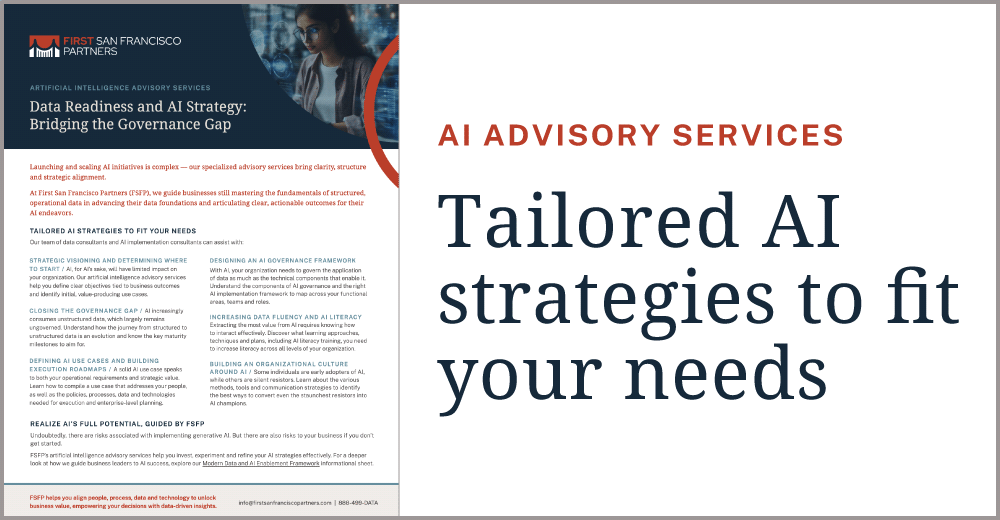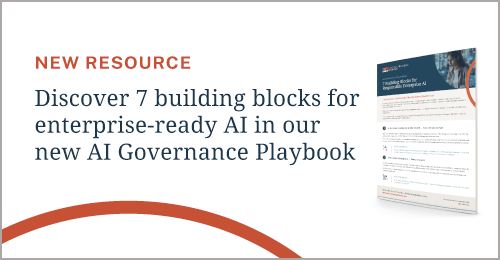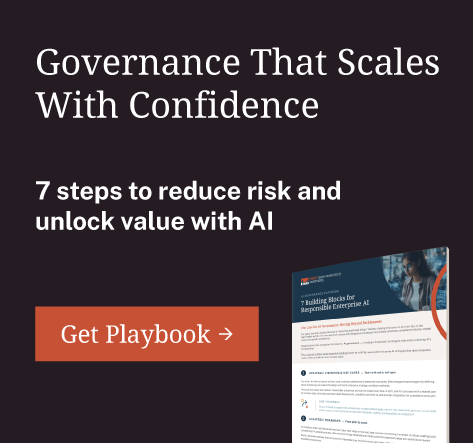It’s an exciting time to be working in the data industry. Last week, I joined 4,000 enthusiasts at Gartner’s 2019 Data & Analytics Summit in Orlando to learn about major trends, predictions and best practices for creating a future based on trusted data, dependable analytics and transformative insights.
Here are a few things I learned at this great event.
Leading with Purpose: Principles Lead, Rules Follow
It’s no secret that ambiguity can be inherent in many data and analytics programs, with objectives and scope shifting between different areas of the enterprise. Regardless, many organizations are invested in finding gold in their mountains of data, with IDC predicting worldwide revenue for big data and business analytics solutions to reach $260B by 2022.
Since data is connected to nearly every part of a business, it’s imperative for data leaders to create a shared vision of how to use data to enable widescale cooperation. The key is clarity of purpose, and I found this year’s theme and keynote on how to “Lead with Purpose to Achieve Clarity in a World of Ambiguity” very timely and pragmatic.
Whether the driving purpose for data and analytics in your organization involves empirical decision-making, data-centric business models or digital transformation — essentially, these are all just ideas until they’re communicated as an enterprise vision. (If this sounds daunting, it needn’t be. Check out our ebook on Becoming a Data-Driven Organization: A Five-Step Process for a practical guide on how to get started.)
With data and analytics in a constant state of evolution, Gartner warns that there’s too much complexity to rely on specific rules to navigate ambiguity. Instead, leaders must be clear about data principles and advocate the mantra that “principles lead, rules follow.” Here at FSFP, we also let guiding principles lead, followed by policies, standards and lastly, processes.
Overcoming Data-Driven Ambiguity
While many organizations have committed to being data-driven, it’s not always a guaranteed path to success, especially when too much ambiguity exists or you rely on a foundation of bad data. As Gartner analyst Donald Feinberg questioned, “Are we building a data-driven organization or a tyranny of metrics?”
He specifically cautioned against two potential traps of being data-driven: unintended consequences and lack of effort. By only using available data and collecting easy-to-measure metrics, you might miss out on new, competitive insights or leading indicators. Worse yet, you could enable a “tyranny of metrics” that stifles creativity and negatively impacts team morale. Instead, Feinberg recommends establishing a data-driven culture that adopts a humble scientific method approach, with the following guiding principles.
Principles of data-driven:
- Challenge data-driven decision-making
- Anticipate unintended consequences of metrics
- Experiment with new data and analytic models
Overcoming Ambiguity in Privacy
Concerns about the proliferation of data and its impact on data privacy are not new but they are growing in importance, especially on the heels of GDPR and CCPA, among others. The conflict of privacy vs. personalization is a delicate balancing act. As Gartner analyst Valerie Logan probed, “Is the paradox that the more we want to be respectful of privacy, the more data we have to collect for context and situational awareness?”
In today’s AI-and-digital-rich world, privacy has moved from opt-in to opt-out and nowadays it seems virtually impossible to track who has captured our data across the online ecosystem. While it’s certainly true that delivering a seamless, personalized, connected and memorable customer experience is a competitive differentiator, so is the critical arena of data privacy and ethics — and particularly, your organization’s approach to it.
Transparency and integrity is paramount. After all, the data your organization has is less important than how you use it. Logan urged us all to be the guides and guardians of our customers’ data. She explained that in our role as guides, we should be navigators and explorers of organizational knowledge. As guardians, we should ensure data relevancy and serve as translators and teachers of data literacy, knowing what data can be trusted and what must be done to protect against internal and external abuse. As guides and guardians on the frontline of data, we can ensure that our organization has the data we need — but only the data we need.
Principles of privacy:
- Privacy, as we have known it, no longer exists
- Leverage transparency to create trust
- Treat customers’ data as they want it to be treated (twist on the golden rule)
Overcoming Ambiguity in AI
Another area with qualities of ambiguity is AI. Although people and machines have long benchmarked themselves against each other, we are facing a period of unprecedented disruption. Today’s digital business landscape represents a convergence of increasingly complex requirements and technology innovations. While some may have an apocalyptic view of AI, Gartner analyst Carlie Idoine reinforced the reminder that AI is about augmentation, not replacement. Recent survey data showed that mistrust and fear of AI decreased once respondents saw it in action in a business context and understood the complementary nature of AI technology.
She also reminded us that AI innovation is meant to create more jobs, just not the same jobs. As Idoine explained, the value of AI is that it can automate the manual and promote the creative. In other words, machines can optimize tedious tasks, freeing up more time for us to pursue more fulfilling endeavors. Gartner believes we are headed toward a pervasive trajectory that will impact our day-to-day: By 2021, 25% of digital works will use a virtual employee assistant on a daily basis.
It’s also important to remember that while AI can apply advanced analysis and logic-based techniques such as machine learning to interpret events and enable decisions, we shouldn’t blindly follow AI calculation.
Principles of AI:
- Algorithmic decision making is inevitable
- Focus on augmentation not replacement
- Play to AI and Humans’ respective strengths
Data Literacy is Key
While there may always be areas of ambiguity in the data work that we do, having guiding principles and clarity of purpose is essential. Workforce data literacy and the ability to read, write and communicate data in context is also central to success — and the need to champion it is urgent. According to Gartner, data literacy continues to be both a critical challenge and an opportunity.
Gartner's data literacy predictions for 2020:
- Fifty percent of organizations will lack sufficient AI and data literacy skills to achieve business value.
- Organizations that offer users access to a curated catalog of internal and external data will realize twice the business value from analytics investments than those that do not.
- The number of data and analytics experts in business units will grow at three times the rate of experts in IT departments, which will force companies to rethink their organizational models and skill sets.
- Eighty percent of organizations will initiate deliberate competency development in the field of data literacy, acknowledging their extreme deficiency.
As always, thanks to Gartner for a terrific and thought-provoking conference! Were you in Orlando? What were your top takeaways?
Article contributed by Czarina Carden. She more than 15 years of marketing experience includes working with start-up to midsize, B2B and B2C companies, as well as currently running a small marketing firm. Czarina focus on leveraging customer-first marketing strategies and messaging to create trust, emotional connections and value-add conversations between organizations and their customers.
Array



